
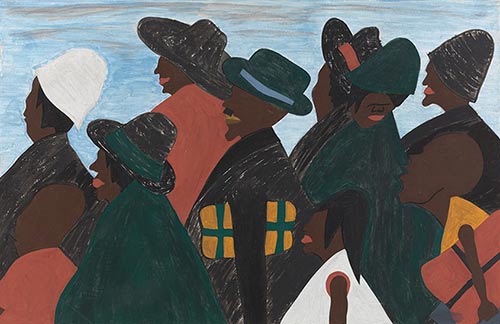
Fresh Meadows
193-20 Horace Harding Expressway, Fresh Meadows
The Migration Series Panel 35 (1940-41)
Jacob Lawrence
This is a panel from Jacob Lawrence's Migration Series. The caption reads, "They left the South in great numbers. They arrived in the North in great numbers."
Almost 80 years ago, young artist Jacob Lawrence set to work on an ambitious 60-panel series portraying the Great Migration, the flight of more than a million African Americans from the rural South to the industrial North following the outbreak of World War I. Before painting the series, Lawrence researched the subject and wrote captions to accompany each panel. Like the storyboards of a film, he saw the panels as one unit, painting all 60 simultaneously, color by color, to ensure their visual unity. The poetry of Lawrence's epic statement emerges from its staccato-like rhythms and repetitive symbols of movement: the train, the station, ladders, stairs, windows, and the surge of people on the move. Following the example of the West African storyteller, who spins tales of the past that have meaning for the present and the future, Lawrence tells a story that reminds us of our shared history and at the same time invites us to reflect on the universal theme of struggle in the world today.
Source: The Phillips Collection phillipscollection.org3
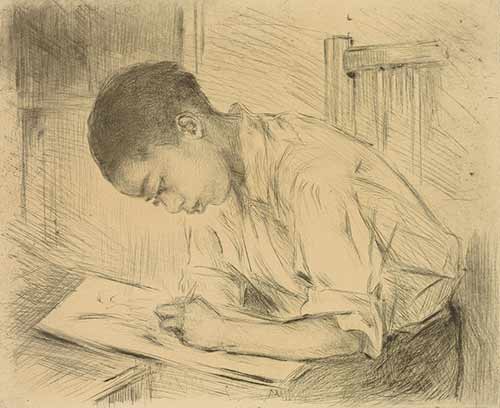
Glen Oaks
256-04 Union Turnpike, Glen Oaks
Young Negro Drawing (1937-1942)
Mathilde de Cordoba
A young African-American boy sitting at a desk drawing with pencil on paper.1
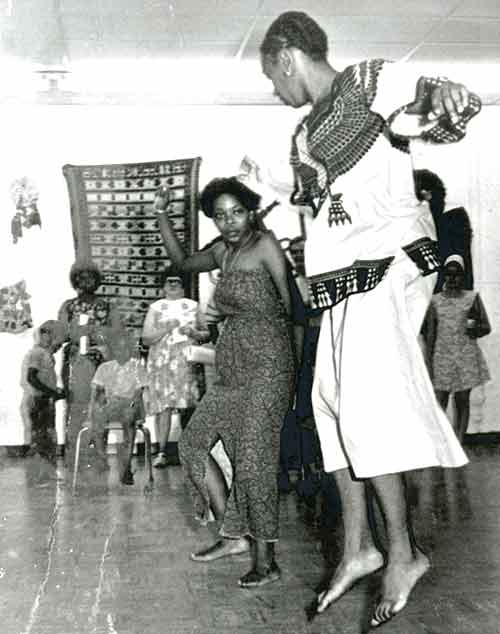
Glendale (Temporary Location)
8000 Cooper Avenue, Glendale (Atlas Park Mall)
Untitled
Dancers at Preview Festivities, Storefront Museum second exhibition, “Geographical Scene Africa,” July 31, 19716

Hillcrest
187-05 Union Turnpike, Flushing
What We Bring: Domestic Workers’ Bill of Rights
Christine Yvette Lewis
“I love the kids I take care of — money can’t begin to pay for that.”9
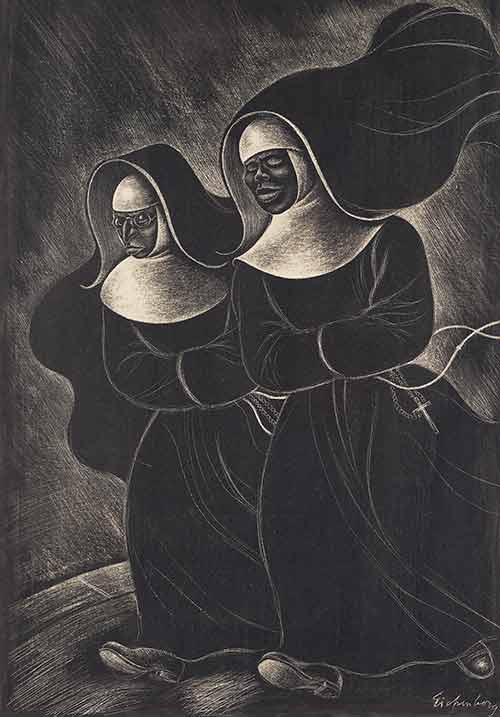
Hollis
202-05 Hillside Avenue, Hollis
Negro Nuns (1937-1942)
Fritz Eichenberg
Two nuns dressed in habit walking side by side.2
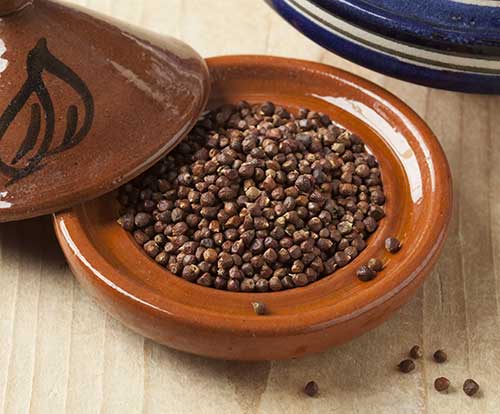
Howard Beach
92-06 156 Avenue, Howard Beach
Grains of Paradise
When cracked like coriander between the teeth, the flavor of grains of paradise releases a billowing aroma, with a slowly intensifying heat, like pepper, at the back of the mouth. The taste changes by the second with lingering heat. The spice is pleasantly tempered, with flavors reminiscent of jasmine, hazelnut, butter and citrus, with an oiliness similar to nuts... Grains of paradise are native to the coastal areas of Africa's Gulf of Guinea which includes today's countries of Liberia, Ivory Coast, Togo, Nigeria, and Cameroon where grains of paradise have a long-standing record of ethnobotanical use. Before the spice trade routes from Western Europe to the East Indies were established, a lively trade of grains of paradise, cubeb, and long peppers existed. Oceanic travels to the spice islands by the Portuguese, Dutch, and English in the 17th century diminished the value and importance of grains of paradise in the face of competition of black pepper, clove, mace, and nutmeg.
Source: Purdue University

Jackson Heights
35-51 81 Street, Jackson Heights
Talking Drum
Talking drums are various types of drums that can imitate the rhythm, rise, and fall of actual words, and are used as communication devices that can send messages over many miles. These drums are known for their distinct hourglass shape and can be found in East and West Africa, Melanesia, and Southeast Asia. Examples include the dùndún pressure drums of the Yoruba and the atumpan and fontomfrom of the Asante.
Source: BBC, Encyclopedia Britannica

Kew Gardens Hills
72-33 Vleigh Place, Flushing
The Green Book
From 1936 to 1966 (with only a pause for WWII), postal worker Victor Green from New Jersey published the directories known today as the Green Book. (The actual titles were variously: The Negro Motorist Green Book; The Negro Travelers' Green Book; The Travelers' Green Book.) These listed—first in NYC only, later throughout much of the world—hotels, restaurants, beauty salons, nightclubs, bars, and gas stations where black travelers would be welcome. In an age of sundown towns, segregation, and lynching, the Green Book became an indispensable tool for safe navigation.
Victor's introductions always concluded:
There will be a day sometime in the near future when this guide will not have to be published. That is when we as a race will have equal opportunities and privileges in the United States. It will be a great day for us to suspend this publication for then we can go wherever we please, and without embarrassment. But until that time comes we shall continue to publish this information for your convenience each year.
He continued publication until just after the passage of the Civil Rights Act of 1964.
Source: The New York Public Library, Schomburg Center for Research in Black Culture
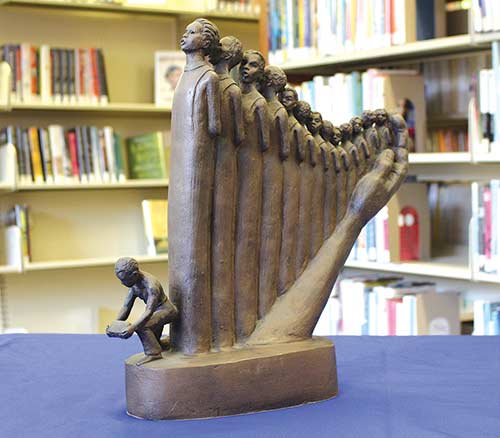
Langston Hughes
100-01 Northern Boulevard, Corona
The Harp
This replica of Augusta Savage’s The Harp can be found right here at Langston Hughes Community Library. The original sculpture, which was influenced by the poem and song “Lift Every Voice and Sing” by James Weldon Johnson, was commissioned for the New York World’s Fair in 1939. The original was destroyed after the World’s Fair, but it remains a powerful symbol of the song and of the black experience.7
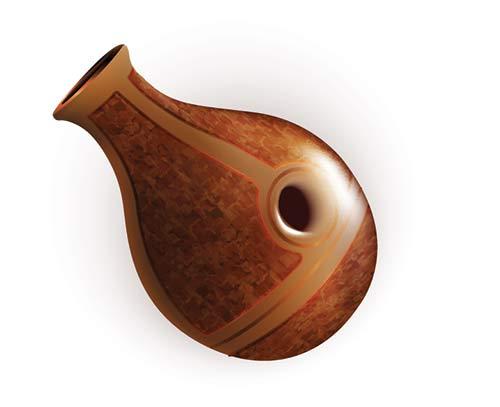
Laurelton
134-26 225 Street, Laurelton
Udu
The udu is a percussion pot from the Igbo people of southern Nigeria. Traditionally a woman’s instrument, the udu traveled first to neighboring tribes and then around the world to become a favorite instrument in any hand drummer’s arsenal. Traditionally, udu were simple water jugs with a second hole, but now they come in a wide variety of shapes and sizes and have led to many new innovations. Usually udu are made from a light porous clay with iron or other metal mixed in to provide a better ring when hit.
Source: Play the World: The 101 World Instrument Primer, Randy Raine-Reusch, Mel Bay Publications, 2015.
1 Courtesy of the Fine Arts Collection, U.S. General Services Administration Federal Art Project NYC WPA. On extended loan to Queens Library. Contact digitalarchives@queenslibrary.org for research and reproduction requests.
2 Courtesy of the Fine Arts Collection, U.S. General Services Administration New Deal Art Project. On extended loan to Queens Library. Contact digitalarchives@queenslibrary.org for research and reproduction requests.
3 1940–41, Casein tempera on hardboard, 12 x 18 in. The Phillips Collection, Washington, DC, Acquired 1942. phillipscollection.org.
4 1940–41, Casein tempera on hardboard, 12 x 18 in. The Museum of Modern Art, New York. Gift of Mrs. David M. Levy.
5 Courtesy of the Fine Arts Collection, U.S. General Services Administration New York City WPA Art Project. On extended loan to Queens Library. Contact digitalarchives@queenslibrary.org for research and reproduction requests.
6 Courtesy of the Queens Library, Archives, Storefront Museum Collection.
7 This replica of Augusta Savage’s The Harp is part of the Langston Hughes Community Library’s Black Heritage Reference Center.
8 Harvey Wang, Courtesy of the Queens Library, Archives, Queens Council on the Arts Collection. Copyright: Harvey Wang.
9 Courtesy of City Lore, What We Bring: Immigrant Gifts exhibit, on view at Central Library until March 2. Cosponsored by City Lore, Center for Traditional Music and Dance, the Brooklyn Arts Council, and the CATCH consortium. Curated by Tom Van Buren and Steve Zeitlin. Funded by the Andrew W. Mellon Foundation with additional support from the New York State Council on the Arts and the NYC Department of Cultural Affairs. Photography by Tom Pich.
10 Queens Library, Archives, Queens Borough Public Library Photographs.
11 Courtesy of the Queens Library, Archives, Frederick J. Weber Photographs. Copyright: Estate of Frederick J. Weber.